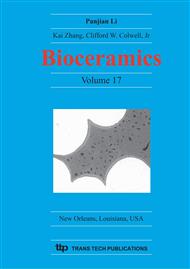p.1011
p.1015
p.1019
p.1023
p.1027
p.1033
p.1037
p.1041
p.1045
Development of an Alumina Ceramic with a Gradient of Concentration and Microstructure for the Application of Load Bearing Implants
Abstract:
Alumina and zirconia have played an important role in joint endoprosthetics for the use in tribologically loaded implant components like hip joint heads and cups for years. In our investigations we prepared an alumina ceramic with a gradient in concentration of zirconia. The zirconia content was realized by infiltration processes with different ZrO2 – precursors. The material was characterized concerning ZrO2-distribution, infiltration depth and microstructure.
Info:
Periodical:
Pages:
1027-1032
Citation:
Online since:
April 2005
Authors:
Keywords:
Price:
Сopyright:
© 2005 Trans Tech Publications Ltd. All Rights Reserved
Share:
Citation:


